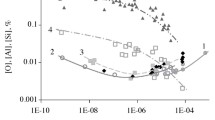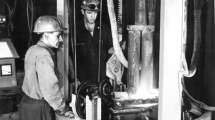Abstract
In the analysis of electroslag remelting, attention is focused here on how rotation of the consumable electrode affects the physicomechanical properties of the ingot (billet) produced. In electroslag remelting with rotation of the consumable electrode around its axis, an ascending heat flux is formed in the slag bath. That improves the hydrodynamic conditions in the mold in terms of heat utilization. With rotation of the consumable electrode, centrifugal forces act on the film of liquid metal formed at the end of the electrode, resulting in radial flow of the metal droplets. The droplets subsequently break away from the electrode perimeter. Thus, the droplets of electrode metal enter the metal bath closer to the mold wall. That ensures a more uniform temperature front in the bath. With decrease in the temperature gradient over the bath cross section, a flatter solidification front is obtained. Such electroslag remelting with rotation of the consumable electrode will affect the physicomechanical properties of the ingot (billet) produced. Remelting trials are conducted to establish the resulting influence on the metal properties. Data are presented for the experimental electroslag remelting of AISI420 streel electrodes in an A-550 system, using different methods. The experimental data show how rotation of the consumable electrode affects the remelting conditions, the solidification of the ingot, and its physicomechanical properties. Its influence on the ingot properties is of particular interest: data regarding the microhardness, density, and size of the dendritic cell in the experimental samples are analyzed. It is found that, in electroslag remelting with rotation of the consumable electrode, the microhardness is more uniform in the transverse direction. In addition, with rotation of the consumable electrode, the dendritic cell is smaller, and the ingot density is higher, than in the classical technology without electrode rotation.




Similar content being viewed by others
REFERENCES
Medovar, B.I., Tsykulenko, K.A., Bogachenko, A.G., and Litvinchuk, V.M., Elektroshlakovaya tekhnologiya za rubezhom (Electroslag Technology Abroad), Kiev: Naukova Dumka, 1982.
Klyuev, M.M. and Volkov, S.E., Elektroshlakovyi pereplav (Electroslag Remelting), Moscow: Metallurgiya, 1984.
Jardy, J., Ablitzer, D., and Wadier, J.F., Magnetohydrodynamic and thermal behavior of electroslag remelting slags, Metall. Trans. B, 1991, vol. 22, pp. 111–120.
Paton, B.E. and Medovar, L.B., Improving the electroslag remelting of steel and alloys, Steel Transl., 2008, vol. 38, no. 12, pp. 1028–1032.
Chumanov, V.I. and Chumanov, I.V., Technology for electroslag remelting with rotation of the consumable electrode, Metallurgist, 2001, vol. 45, nos. 3–4, pp. 125–128.
Paar, A., Schneider, R., Zeller, P., Reiter, G., Paul, S., Siller, I., and Würzinger, P., Influence of the polarity on the cleanliness level and the inclusion types in the ESR process, Proc. 2013 Int. Symp. on Liquid Metal Processing & Casting, September 22–25, 2013, Austin, USA, New York: Springer-Verlag, 2013, pp. 29–36.
Wang, Q., Li, G., He, Z., and Li, B., A three-phase comprehensive mathematical model of desulfurization in electroslag remelting process, Appl. Therm. Eng., 2017, vol. 114, pp. 874–886.
Wang, Q., Liu, Y., Li, G., Gao, Y., He, Z., and Li, B., Predicting transfer behavior of oxygen and sulfur in electroslag remelting process, Appl. Therm. Eng., 2018, vol. 129, pp. 378–388.
Kawakami, M., Takenaka, T., and Ishikawa, M., Electrode reactions in DC electroslag remelting of steel rod, Ironmaking Steelmaking, 2002, vol. 29, no. 4, pp. 287–292.
Paar, A., Schneider, R., Zeller, P., Reiter, G., Paul, S., and Würzinger, P., Effect of electrical parameters on type and content of non-metallic inclusions after electro-slag-remelting, Steel Res. Int., 2014, vol. 85, no. 4, pp. 570–578.
Chang, L.Z., Shi, X.F., Yang, H.S., and Li, Z.B., Effect of low-frequency AC power supply during electroslag remelting on qualities of alloy steel, J. Iron Steel Res. Int., 2009, vol. 16, no. 4, pp. 7–11.
Ayman, F., Azza, A., Hoda, E.F., and Mamdouh, E., Behavior of precipitates and inclusions during ESR of nitrogen alloyed and conventional AISI M41 high speed steels, Steel Grips, 2006, vol. 4, no. 4, pp. 298–304.
Duckworth, W.E. and Hoyle, G., Electro-Slag Refining, London: Chapman & Hall, 1969.
Karimi Sibaki, E., Kharicha, A., Wu, M., Ludwig, A., Holzgruber, H., Ofner, B., and Ramprecht, M., A numerical study on the influence of the frequency of the applied AC current on the electroslag remelting process, Proc. 2013 Int. Symp. on Liquid Metal Processing & Casting, September 22–25, 2013, Austin, USA, New York: Springer-Verlag, 2013, pp. 13–19.
Chumanov, I.V. and Chumanov, V.I., Control of the carbide structure of tool steel during electroslag remelting: Part I, Russ. Metall. (Engl. Transl.), 2011, vol. 2011, no. 6, pp. 515–521.
Chumanov, V.I., Belozerov, B.P., and Chumanov, I.V., Mathematic model of rotating electrode remelting, Izv. Vyssh. Uchebn. Zaved., Chern. Metall., 1991, no. 12, pp. 74–75.
Chumanov, I.V. and Chumanov, V.I., Increasing the efficiency of the electroslag process and improving the metal quality by rotating consumable electrode: Part I, Russ. Metall. (Engl. Transl.), 2010, vol. 2010, no. 6, pp. 499–504.
Chumanov, I.V. and Pyatygin, D.A., Features of electroslag remelting with direct current and rotation of consumable electrode, Izv. Vyssh. Uchebn. Zaved., Chern. Metall., 2006, no. 3, pp. 22–25.
Leibenzon, S.A., Elektroshlakovyi pereplav i kachestvo metalla (Electroslag Remelting and Metal Quality), Moscow: Metallurgiya, 1965.
ACKNOWLEDGMENTS
Financial support was provided by a grant from the Russian President (contract 14.Y30.18.2874-MK).
Author information
Authors and Affiliations
Corresponding authors
Additional information
Translated by Bernard Gilbert
About this article
Cite this article
Chumanov, I.V., Matveeva, M.A. & Sergeev, D.V. Influence of Electrode Rotation in Electroslag Remelting on the Anisotropy of Ingot Properties. Steel Transl. 49, 77–81 (2019). https://doi.org/10.3103/S0967091219020050
Received:
Revised:
Accepted:
Published:
Issue Date:
DOI: https://doi.org/10.3103/S0967091219020050




